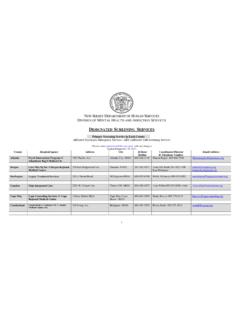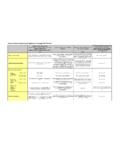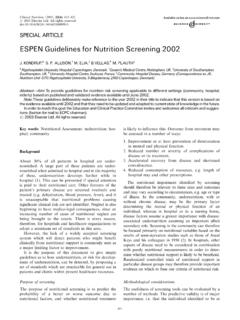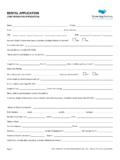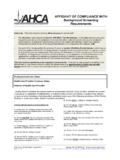Transcription of Screening for Type 2 Diabetes - WHO
1 WHO/NMH/ Original: EnglishScreening for Type 2 DiabetesReport of a world health organization andInternational Diabetes Federation meeting world health OrganizationDepartment of Noncommunicable Disease ManagementGenevaWHO/NMH/ Original: EnglishScreening for Type 2 DiabetesReport of a world health organization andInternational Diabetes Federation meeting world health OrganizationDepartment of Noncommunicable Disease ManagementGenevaScreening for Type 2 Diabetes world health organization 2003 All rights reserved.
2 Publications of the world health organization can beobtained from Marketing and Dissemination, world health organization , 20 Avenue Appia, 1211 Geneva 27, Switzerland (tel: +41 22 791 2476; fax: +4122 791 4857; email: Requests for permission toreproduce or translate WHO publications whether for sale or fornoncommercial distribution should be addressed to Publications, at theabove address (fax: +41 22 791 4806; email: world health organization does not warrant that the informationcontained in this publication is complete and correct and shall not be liable forany damages incurred as a result of its publication contains the collective views of an international group ofexperts and does not necessarily represent the decisions or the stated policy ofthe world health and its for type 2 Diabetes why WHO and IDF convened this of Screening on individuals, health systems and and prevention - the links.))
3 43 Aims of the meeting ..54 Terminology what is Screening ..55 Evaluating Screening tests and specific to of available Screening of Screening tests for type 2 Combinations of Public response to Screening for type 2 Frequency of the risk of future development of type 2 current evidence relating to the efficacy of early relating to economic aspects of early relating to the psycho-social effects of early policies about Screening for type 2 aims and objectives of a Screening of health system choice of a test or
4 Priorities .. and political the evidence base .. need for evidence from randomized controlled need for observational need for economic use of modelling need for evidence on the psycho-social effects of early policies about Screening for type 2 Conclusions and 30 Annex 1 List of participants of the WHO/IDF and the past decade it has been obvious that the prevalence of type 2 diabetesis increasing rapidly. Unless appropriate action is taken, it is predicted thatthere will be at least 350 million people in the world with type 2 Diabetes bythe year 2030.
5 This is double the current number. Equally alarming and lesswell known is the fact that, of these people, only around one half are known tohave the condition. This has been shown repeatedly in epidemiologicalsurveys. An added concern is that half of those who do present with type 2diabetes clinically already have signs of the complications of the has not yet been proven that earlier detection will improve the outcome ofpeople with type 2 Diabetes , but it seems logical to suggest that it may implication of this is that people need to be screened for Diabetes on aregular basis.
6 There is still uncertainty whether this should be done on apopulation-wide basis or just for those people who can be shown to have ahigh risk. It is also uncertain at what age the Screening programmes should beintroduced, if at report focuses solely on Screening for type 2 Diabetes in non-pregnantadults. It does not consider Screening for type 1 Diabetes , Screening for type 2diabetes in children, nor Screening for gestational Diabetes . This is not toimply that these topics are unimportant.
7 On the contrary, they are eachimportant enough to require detailed consideration in their own is clear to both the world health organization (WHO) and the InternationalDiabetes Federation (IDF) that guidance is needed for both our membercountries and member associations. Because of this the WHO and the IDFhave come together to produce this document, which, though it poses as manyquestions as it answers, is a clear and logical start to a very serious hope that the report will provide guidance and provoke discussion andnew studies and in the long term will be of benefit to the many people in theworld with and at risk of type 2 Derek YachProfessor Sir George AlbertiExecutive DirectorPresidentNoncommunicable Diseases International Diabetes Federationand Mental health ClusterWorld health and its consequencesDiabetes mellitus is a metabolic disorder
8 Characterized by chronichyperglycaemia with disturbances of carbohydrate, fat and proteinmetabolism resulting from defects in insulin secretion, insulin action,or both1. The current diagnostic criteria are shown in Table 1 Insummary, Diabetes is diagnosed if the (venous) fasting plasma glucose(FPG) value is >= mmol l-1 (126 mg dl-1), or if the casual plasmaglucose value is >= mmol l-1 (200 mg dl-1), or if the plasmaglucose value 2 hours after a 75g oral load of glucose >= mmol l-1(200 mg dl-1).
9 In asymptomatic subjects, performing the test on oneoccasion is not enough to establish the diagnosis ( basis to treatdiabetes). This must be confirmed by carrying out at least one furthertest on a subsequent glucose tolerance (IGT) and impaired fasting glycaemia(IFG) are risk categories for the future development of Diabetes andcardiovascular disease (CVD). An individual falling into the IFGcategory on the fasting result may also have IGT on the 2-h value or,indeed, Diabetes .
10 If an individual falls into two different categories, themore severe one classification of Diabetes is based on aetiological types1. Type 1indicates the processes of beta-cell destruction that may ultimately leadto Diabetes in which insulin is required for survival. Type 2 Diabetes ischaracterized by disorders of insulin action and /or insulin third category, "other specific types of Diabetes ," includes diabetescaused by a specific and identified underlying defect, such as geneticdefects or diseases of the exocrine latest WHO Global Burden of Disease estimates the worldwideburden of Diabetes in adults to be around 173 million in the year 20023.










